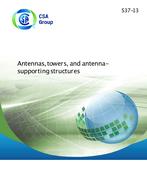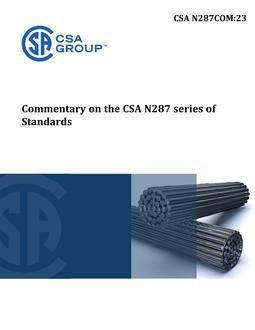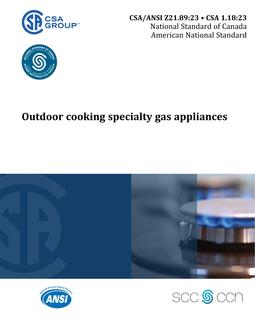
CSA S37-13
- Comments Off on CSA S37-13
- CSA
Preface
This is the seventh edition of CSA Standard S37, Antennas, towers, and antenna-supporting structures. It supersedes the previous editions published in 2001, 1994, 1986, 1981, 1976, and 1965. Antennas, towers, and antenna-supporting structures comprise a group that can be described as communication structures. They are usually of lattice steel construction, but may be of solid or tubular construction and may use a variety of materials. They may be guyed or self-supporting, and some structures may be mounted on platforms or building rooftops. The principal loads are wind and ice, while earthquake effects require a design check for designated post-critical installations in regions of medium to high seismicity. This Standard is written to address these special characteristics using the applicable sections of other CSA structural design standards. It also refers to the National Building Code of Canada for the specification of seismic spectral accelerations. Most design standards are written to address the requirements of new structures. The Technical Committee for this Standard has also been concerned about the effect of changes on existing structures. While it is not mandatory to upgrade existing towers when new editions of the Standard are published, communication structures are frequently subject to changes in attached equipment. This necessitates conformance with the current edition. Changes are therefore carefully considered so as not to cause significant economic impact as a result of minor changes in equipment. The latest amendments to Part II of the Canada Occupational Safety and Health Regulations (COSH) of the Canada Labour Code require that the design and construction of every tower, antenna, and antenna-supporting structure meet the requirements of this Standard as amended from time to time. This requirement may be modified for an antenna if the electronic performance cannot be achieved. Safety of persons who are required to climb a tower is as important a consideration as the safety of the structure; therefore, requirements for ladders, safety devices, platforms, and cages are included as part of this Standard. This edition of the Standard has undergone an extensive editorial revision to clarify certain clauses and make it more uniform in language. It also introduces mandatory seismic checks for all designated post-critical structures that must remain serviceable immediately after an earthquake. It has long been recognized that some structures, particularly tall guyed masts, can be subject to dynamic effects that require a more in-depth study of the loads and responses than that provided by static analysis procedures. This Standard does not have mandatory requirements for dynamic analysis, but it does provide a quasi-dynamic patch-loading procedure, which is recommended for the analysis of wind effects on such towers. CSA Group acknowledges that the development of this Standard was made possible, in part, by the financial support of Bell Mobilite, Nav Canada, Hydro-Quebec, Rogers Communication Partnership, CBC Ontario, NorthWesTel Inc. and Manitoba Hydro.
Scope
1.1 General This Standard applies to structural antennas, towers, antenna-supporting structures, and roof- and wall-mounted structures, including their components, such as guys and foundations. It covers the structural design, fabrication, and erection of new structures and the modification of existing structures. 1.2 Exclusions This Standard is not intended to apply to a) attachment antennas and arrays or assemblies of such antennas; or b) towers that support attachment antennas, extending less than 15 m above grade, including the height of any structure on which they are mounted. 1.3 Unusual designs and antennas This Standard covers the requirements for most structural antennas, antenna towers, and antenna-supporting structures, but it is recognized that structures that are unusual with regard to their height or shape, or with regard to the shape and size of individual members, or that are located on sites having unusual topographical, geological, or climatic conditions might not be adequately covered. In such cases, appropriate engineering principles providing a level of reliability at least equivalent to that provided by this Standard should be applied. 1.4 Dynamic effects of wind This Standard does not contain mandatory requirements that take into account the dynamic effects of wind. 1.5 Other design approaches A rational design based on theory, analysis, and engineering practice, acceptable to the owner and regulatory authority, may be used in lieu of the design procedures or materials described in this Standard. In such cases, the design should be prepared by an engineer qualified in the specific method and knowledgeable about the materials to be used, and should provide a level of safety and performance that is not less than that implicit in this Standard. 1.6 Local, provincial, and federal regulations Responsibility for observing all applicable local, provincial, and federal regulations is not relieved by compliance with this Standard. 1.7 Terminology In this Standard, “shall” is used to express a requirement, i.e., a provision that the user is obliged to satisfy in order to comply with the standard; “should” is used to express a recommendation or that within the limits of the standard. Notes accompanying clauses do not include requirements or alternative requirements; the purpose of a note accompanying a clause is to separate from the text explanatory or informative material. Notes to tables and figures are considered part of the table or figure and may be written as requirements. Annexes are designated normative (mandatory) or informative (non-mandatory) to define their application.
Product Details
- Edition:
- 7th
- Published:
- 11/01/2013
- ISBN(s):
- 9781771390224
- Number of Pages:
- 221
- File Size:
- 1 file , 2.6 MB
- Product Code(s):
- 2422031, 2422031



